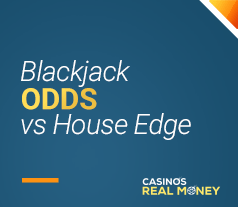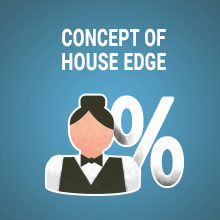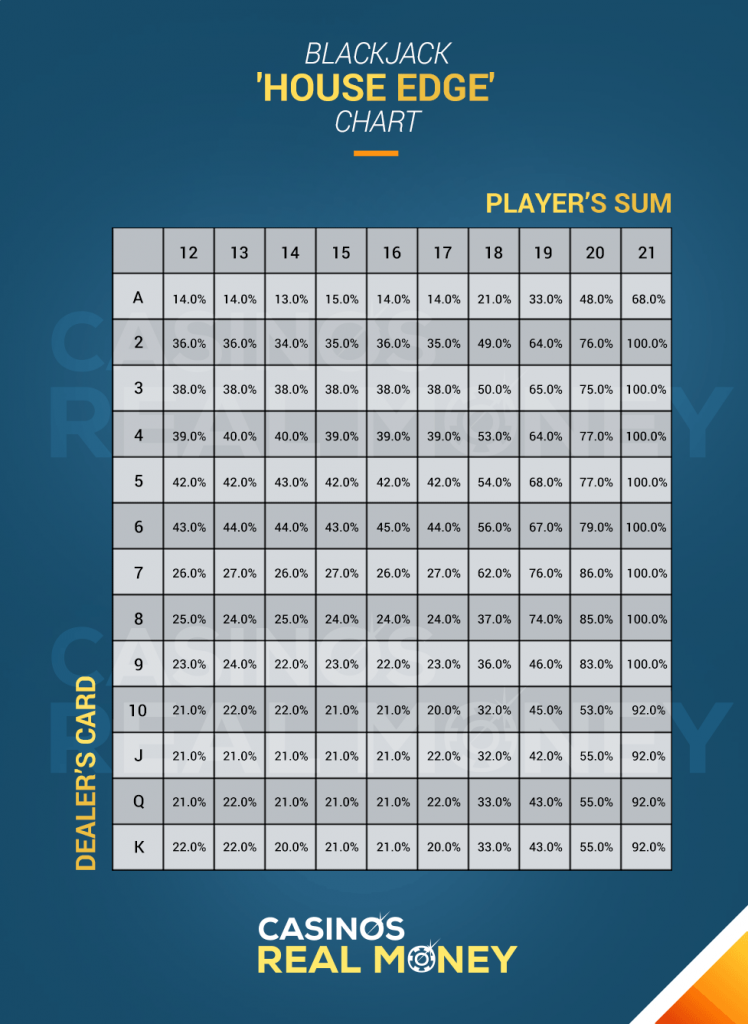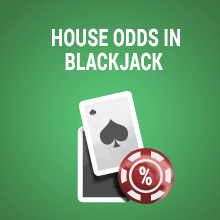Blackjack Odds vs House Edge Probabilities

For many players, the excitement of the game is just one part of what draws them to Blackjack. There is an opportunity to reduce the casino’s advantage, making it a terrific game for both casual gamblers and pros.
In this game, the numbers are everything, and you must choose wisely based on the odds. It’s all too easy to give in to impulse and let your instincts guide your decisions.
That ought not to be the case at all.
Knowing the probability of every scenario and basing all decisions on them is the only way to play perfectly and master blackjack.
Getting Started with Blackjack Odds
Variables like the number of decks in use and the blackjack game version being played have a significant impact on the real odds. To calculate the odds of blackjack, divide total winning outcomes by total possible outcomes.
This is the most common way to compute the probability.
If you’re having trouble grasping the concept of these odds, consider the meanings of these two phrases. A positive or negative predicted win rate is used to indicate the chances you have in a certain situation throughout the game. Additionally, the term “true odds” is a typical one that describes a bet that pays off at the same rate as the probability percentage predicts.
A player must always be informed of the blackjack odds of winning and busting no matter what cards they have been dealt or what circumstance they find themselves in.
Concept of the Blackjack House Edge

The principal source of a casino’s income is the advantage it has over players, or what is known as the “house edge.” The more you play, the more money the casino makes from you. Statistics acquired from millions of simulated games are used to calculate this ‘house edge’ blackjack casinos all adopt.
There is no way to get around the fact that the house always has an edge when gambling, regardless of whether you do it offline or online. Therefore, if you want to make the most of your real-money investment, it is essential to have a strategy that allows you to compete well against the house.
The goal is to reduce the advantage as much as possible.
Why Do Casinos Implement the House Edge?
The most straightforward response to this question is that gambling establishments are in business to generate a profit. They give the atmosphere, the place, and all services that you could need while you are gaming.
A casino will stop at nothing to make its establishment seem appealing to customers and visitors. Everything associated with this costs money. That includes material resources, entertainment, as well as labor.
It is not a nefarious endeavor, however. As long as you—as the player—understand that there is a house edge and don’t try to beat the house edge then you are in a way paying for a night of interactive entertainment.
Due to the house edge, betting should never be treated as a source of income.
House Edge in Blackjack: The Numbers

The advantage shifts back and forth between the player and the dealer during a game of blackjack. The advantage that the house has over the player is dependent on several different variables. For example, the advantage of the casino over you will be closer to 2 percent than it would be to 0.5 percent if you are a novice player and do not have a well-defined strategy.
There is a possibility that the house advantage will be different at each casino you visit. It might also change depending on the version of the game that you are playing at the time.
In most cases, the Blackjack house odds will be somewhere in the range of 0.5 percent to 4 percent.
That is, if the house has a 4 percent advantage, you may express this mathematically by saying that you will lose $4 for every $100 that you wager. Despite all of this, blackjack has one of the smallest house margins and offers some of the greatest odds of any casino game.
Effective vs Theoretical Edge
Casinos do, without a doubt, have an edge, but the numbers that indicate this advantage are mostly theoretical. That is because when determining the house’s edge in blackjack, the basic strategy is also considered which implies flawless gameplay. Therefore, the house advantage can only be calculated with precision if an infinite amount of money is staked on an infinite number of hands, each hand being played perfectly.
There is always a difference between the theoretical house advantage and the actual one in the game. The reason for this is that no one can ever have the perfect game approach. After a certain number of hands have been dealt, the statistical model’s forecasts began to lean more towards the theoretical figures. Top casinos will deal hundreds of thousands of hands in a single month and this is how the advantage works in their favor.
Gambling is a game of chance for players, but for the casino, it is more of a statistical guarantee. Although the casino’s owners and operators may give out vast sums of money to lucky winners, they will always be able to recoup those funds.
What Are the Odds in Blackjack?

The odds of winning a blackjack hand can’t be defined due to too many variables and will vary widely from one casino or session to the next. It also depends on the variant of blackjack one is playing. There is a possibility that a player’s odds may worsen if the casino uses more decks in the shoe, reduces payouts, and implements stringent blackjack regulations such as not allowing double after splitting.
Players can roughly know their chance of ‘going bust’ based on their combined hand value but again, these estimates can change based on the number of decks being played and other factors.
The following is a rundown of the player’s bust probability if they opt to hit after they have been given the first two cards in the hand:
Blackjack Odds of Going Bust (By Hand)
| Hand value | Probability |
|---|---|
| 11 or lower | 0% |
| 12 | 31% |
| 13 | 39% |
| 14 | 56% |
| 15 | 58% |
| 16 | 62% |
| 17 | 69% |
| 18 | 77% |
| 19 | 85% |
| 20 | 92% |
| 21 | 100% |
In blackjack, the dealer has a high chance of winning. This is because their moves come in second and they make decisions based on the position of the players. However, the house rules might alter the dealer’s chances. The likelihood of the dealer going bust is shown in the following table.
| Dealer’s card | Probability (Stand on 17) |
|---|---|
| Ace | 17% |
| 2 | 35% |
| 3 | 37% |
| 4 | 40% |
| 5 | 42% |
| 6 | 42% |
| 7 | 26% |
| 8 | 24% |
| 9 | 23% |
| 10 | 23% |
These odds might be drastically altered in different situations. The laws of the game, personal tastes, and the sort of blackjack you are playing all influence the outcomes. In certain hands, the odds of winning blackjack rounds are very close between the dealer and the player. Let’s go through a few of them.
16 Against Dealer 10
There are no more small-value cards in the unplayed card pack, thus you should always stand on a 16 if you have three or more cards. When you hit 16, these little cards are just what you need to produce a winning hand.
12 Against Dealer 4
Your chances are marginally higher if you decide to hit, with a 58 percent risk of losing and a 2% chance of a push. A 4 on the dealer’s upcard increases the likelihood that they will bust by 40%. Therefore, if you stand, you will lose the hand 60% of the time.
Hard 16
You need to strike if the dealer has a 7 or an 8. But if 9 or 10 pop up, consider surrendering. Chances of busting are substantial, but it is less likely than the dealer finishing with 17 or more.
15 Against Dealer 10
Here, the dealer has a considerably larger probability of winning than you have. 22% of the time, you will win via hitting. You will have a 23% chance of winning by choosing to stand instead.
12 Against Dealer 3
In this situation, there is a 5% possibility of a push, which means you won’t gain anything but also won’t lose anything either. You have a tiny advantage in the outcome if you hit here. The reasoning is different if you’ve made 12 with two aces since you should always split aces in blackjack.
Low Pairs
If you have two 4s, you should always split when the dealer has a 5 or 6. If you have two 5s, you should never split them. On the other hand, you should always split a pair of aces. If the dealer shows a card between 2 and 6, you should split. On a dealer 7, you should also split 2s and 3s. You shouldn’t split these cards in any other case.
Regardless of the dealer’s hand, you should hit the 2s, 3s, and 4s if you don’t split. The same is true with a pair of 5s, regardless of what the dealer has.
Finally, if the dealer holds cards 2 through 9, you should double since the chances are in your favor for getting a 20. You should hit if you have a pair of 6s and the dealer has more than a 7 in their hand. However, you should divide and hope the dealer busts if the dealer displays a 6 or less.
Summary
Implementing your basic strategy will allow you to lessen the advantage the casino has over you to varying degrees. In addition to this, the composition-dependent basic strategy takes into account the individual cards that make up a player’s hand total rather than just looking at the hand as a whole. Overall, the more you engage in the activity, the more proficient you will get at the game.
Note: In blackjack, your approach will always be determined by the situation you are playing in. Unsurprisingly, gamers may always demand absolutes but even though theoretically speaking, such things do not exist outside of simulations. It’s possible that the optimal strategy for blackjack may change depending on the casino you play in, the number of decks they utilize, or even the specific game variation you choose to engage in. Time to get practising on some real poker sites!



